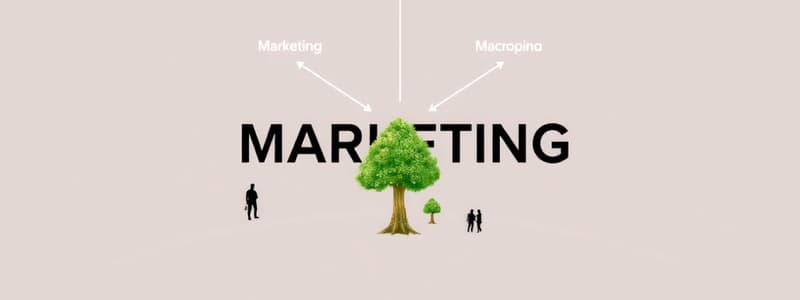Podcast
Questions and Answers
Which of the following is NOT a component of the microenvironment?
Which of the following is NOT a component of the microenvironment?
- Government regulations (correct)
- Customers
- Employees
- Suppliers
Changes in the economic environment do not affect marketing decisions.
Changes in the economic environment do not affect marketing decisions.
False (B)
What are the PESTEL factors that influence the macroenvironment?
What are the PESTEL factors that influence the macroenvironment?
Political, Economic, Social, Technological, Environmental, Legal
A company’s immediate environment that directly influences its operations is known as the ______.
A company’s immediate environment that directly influences its operations is known as the ______.
Match the following components with their definitions:
Match the following components with their definitions:
Which strategy did Microsoft implement to support digital and remote work?
Which strategy did Microsoft implement to support digital and remote work?
Companies cannot react to changes in the marketing environment.
Companies cannot react to changes in the marketing environment.
What is one key change Microsoft is implementing to address environmental concerns?
What is one key change Microsoft is implementing to address environmental concerns?
Which company uses advanced technologies like AI to improve warehouse efficiency?
Which company uses advanced technologies like AI to improve warehouse efficiency?
Pepsi and Coca-Cola are considered competitors in the soft drink market.
Pepsi and Coca-Cola are considered competitors in the soft drink market.
Name one company that focuses on sustainability and how they do it.
Name one company that focuses on sustainability and how they do it.
Apple relies on suppliers like ______ to provide components for its products.
Apple relies on suppliers like ______ to provide components for its products.
Match the business actor with their role:
Match the business actor with their role:
What demographic change has influenced companies like HelloFresh?
What demographic change has influenced companies like HelloFresh?
Economic growth leads consumers to seek affordable products.
Economic growth leads consumers to seek affordable products.
What is the main focus of the non-profit environmental group monitoring Starbucks?
What is the main focus of the non-profit environmental group monitoring Starbucks?
What strategy did Walmart adopt during economic downturns?
What strategy did Walmart adopt during economic downturns?
Patagonia is not concerned about sustainability and relies solely on new materials for production.
Patagonia is not concerned about sustainability and relies solely on new materials for production.
What technology does Amazon use for personalized recommendations?
What technology does Amazon use for personalized recommendations?
Google powers its data centers with _______ renewable energy.
Google powers its data centers with _______ renewable energy.
Match the following companies with their strategies:
Match the following companies with their strategies:
What demographic shift did Starbucks notice?
What demographic shift did Starbucks notice?
Geopolitical tensions do not affect a company's supply chain decisions.
Geopolitical tensions do not affect a company's supply chain decisions.
Name one benefit of investing in renewable energy for companies.
Name one benefit of investing in renewable energy for companies.
Flashcards
Marketing Environment
Marketing Environment
All factors, internal and external, that influence a company's marketing decisions and success.
Microenvironment
Microenvironment
The immediate forces that directly affect a company's operations, such as customers, competitors, suppliers, and employees.
Macroenvironment
Macroenvironment
The larger external forces that affect the entire market, such as political, economic, social, technological, and environmental factors.
Adapting to a Changing Marketing Environment (Example: Microsoft)
Adapting to a Changing Marketing Environment (Example: Microsoft)
Signup and view all the flashcards
Marketing Environment
Marketing Environment
Signup and view all the flashcards
Microenvironment
Microenvironment
Signup and view all the flashcards
Macroenvironment
Macroenvironment
Signup and view all the flashcards
Adapting to a Changing Marketing Environment
Adapting to a Changing Marketing Environment
Signup and view all the flashcards
Company actors
Company actors
Signup and view all the flashcards
Internal R&D
Internal R&D
Signup and view all the flashcards
Suppliers
Suppliers
Signup and view all the flashcards
Marketing Intermediaries
Marketing Intermediaries
Signup and view all the flashcards
Competitors
Competitors
Signup and view all the flashcards
Publics
Publics
Signup and view all the flashcards
Customers
Customers
Signup and view all the flashcards
Sustainability and Environmental Concerns
Sustainability and Environmental Concerns
Signup and view all the flashcards
Rapid Technological Innovation
Rapid Technological Innovation
Signup and view all the flashcards
Growing Focus on Renewable Energy
Growing Focus on Renewable Energy
Signup and view all the flashcards
Shifts in Government Policies and Regulations
Shifts in Government Policies and Regulations
Signup and view all the flashcards
Cultural Shifts and Changing Consumer Values
Cultural Shifts and Changing Consumer Values
Signup and view all the flashcards
Globalization and Geopolitical Tensions
Globalization and Geopolitical Tensions
Signup and view all the flashcards
Demographic Shift
Demographic Shift
Signup and view all the flashcards
Analyzing Demographic Changes
Analyzing Demographic Changes
Signup and view all the flashcards
Study Notes
Analyzing the Marketing Environment
- The marketing environment comprises all internal and external forces influencing a company's marketing activities.
- The microenvironment encompasses internal factors directly impacting operations, including customers, competitors, suppliers, intermediaries, employees, and stakeholders.
- Example: A supplier price increase directly impacts a company's production costs.
- The macroenvironment involves broader, external forces beyond a company's control, such as political, economic, social, technological, environmental, and legal factors (PESTEL).
- Example: An economic downturn affects market demand for products.
Actors in the Microenvironment
- The Company: Internal teams collaborate to develop and market products.
- Suppliers: Provide essential components or resources (e.g., Apple and Foxconn).
- Marketing Intermediaries: Help companies reach customers (e.g., Amazon).
- Competitors: Companies vying for market share (e.g., Pepsi and Coca-Cola).
- Publics: Various groups impacting a brand's image (e.g., environmental groups and customers).
- Customers: Key actors in the microenvironment; companies focus on understanding and meeting their needs.
Actors in the Macroenvironment
- Demographic: Changes in age, gender, and family size impact segments and strategies (e.g., Netflix's portal targeting Gen Z).
- Economic: Economic conditions influence spending habits; recession leads to emphasis on affordability (e.g., Walmart focusing on low prices).
- Natural: Concern for the environment drives interest in eco-friendly products and practices (e.g., Timberland's sustainable products).
- Technological: Advancements in AI, automation, and big data influence efficiency and strategy (e.g., Amazon's AI for personalized recommendations).
- Political: Government regulations impact operations (e.g., EU data privacy law affecting companies like Facebook).
- Cultural: Societal values and trends affect preferences, driving adaptation in products (e.g., Unilever adapting to diverse preferences)
Demographic and Economic Environments
- Demographic shifts impact target markets; younger generations prefer convenience and affordability (e.g., HelloFresh meal kits).
- Economic changes affect purchasing power. Businesses adapt to economic cycles by altering pricing and offerings (e.g., Walmart emphasizing low prices during recessions).
Natural and Technological Environments
- Sustainability and environmental concerns lead to eco-friendly practices (e.g., Patagonia's use of recycled materials).
- Rapid technological advancements lead to increased efficiency and new product options (e.g., Amazon's warehouses and AI use).
- Growing focus on renewable energy sources to reduce environmental impact (e.g., Google using renewable energy in data centers).
Changes in the Political and Cultural Environments
- Shifts in government policies impact business operations and strategies (e.g., government incentives for electric vehicles).
- Evolving cultural shifts and changing consumer values influence preferences, and businesses must adapt (e.g., Dove's Real Beauty campaign).
- Globalization and geopolitical tensions impact supply chains and alliances (e.g., Apple adapting its supply chain due to U.S.-China trade tensions).
Case Study - In-Class Activity
- Starbucks faced a demographic shift with younger customers prioritizing health and affordability.
- Questions: Identify the demographic shift Starbucks faced and its impact on strategy, and how Starbucks attracted price-sensitive younger customers while maintaining loyalty.
Studying That Suits You
Use AI to generate personalized quizzes and flashcards to suit your learning preferences.




